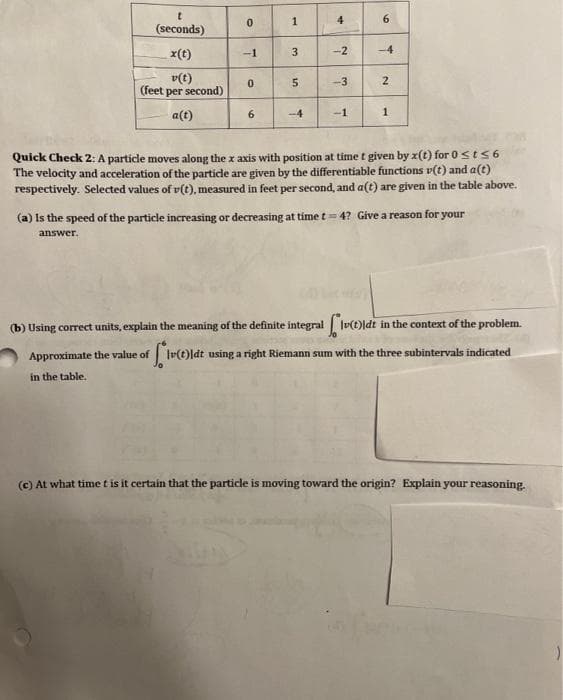4. 6. (seconds) x(t) -1 -2 -4 v(t) (feet per second) -3 a(t) -4 -1 Quick Check 2: A particle moves along the x axis with position at time t given by x(t) for 0sts6 The velocity and acceleration of the particle are given by the differentiable functions v(t) and a(t) respectively. Selected values of v(t), measured in feet per second, and a(t) are given in the table above. (a) Is the speed of the particle increasing or decreasing at time t= 4? Give a reason for your answer. (b) Using correct units, explain the meaning of the definite integral lv(t)ldt in the context of the problem. Approximate the value of lv(t)ldt using a right Riemann sum with the three subintervals indicated in the table. (c) At what timet is it certain that the particle is moving toward the origin? Explain your reasoning. 2. 1, 3. 6.
4. 6. (seconds) x(t) -1 -2 -4 v(t) (feet per second) -3 a(t) -4 -1 Quick Check 2: A particle moves along the x axis with position at time t given by x(t) for 0sts6 The velocity and acceleration of the particle are given by the differentiable functions v(t) and a(t) respectively. Selected values of v(t), measured in feet per second, and a(t) are given in the table above. (a) Is the speed of the particle increasing or decreasing at time t= 4? Give a reason for your answer. (b) Using correct units, explain the meaning of the definite integral lv(t)ldt in the context of the problem. Approximate the value of lv(t)ldt using a right Riemann sum with the three subintervals indicated in the table. (c) At what timet is it certain that the particle is moving toward the origin? Explain your reasoning. 2. 1, 3. 6.
Calculus: Early Transcendentals
8th Edition
ISBN:9781285741550
Author:James Stewart
Publisher:James Stewart
Chapter1: Functions And Models
Section: Chapter Questions
Problem 1RCC: (a) What is a function? What are its domain and range? (b) What is the graph of a function? (c) How...
Related questions
Question

Transcribed Image Text:4
6.
(seconds)
x(t)
-1
3
-2
-4
v(t)
(feet per second)
-3
a(t)
6.
-4
-1
Quick Check 2: A particle moves along the x axis with position at time t given by x(t) for 0sts6
The velocity and acceleration of the particle are given by the differentiable functions v(t) and a(t)
respectively. Selected values of v(t), measured in feet per second, and a(t) are given in the table above.
(a) Is the speed of the particle increasing or decreasing at time t= 4? Give a reason for your
answer.
(b) Using correct units, explain the meaning of the definite integral lv(t)ldt in the context of the problem.
Approximate the value of
|v(t)ldt using a right Riemann sum with the three subintervals indicated
in the table.
(c) At what time t is it certain that the particle is moving toward the origin? Explain your reasoning.
1.
Expert Solution
This question has been solved!
Explore an expertly crafted, step-by-step solution for a thorough understanding of key concepts.
Step by step
Solved in 3 steps with 3 images

Recommended textbooks for you

Calculus: Early Transcendentals
Calculus
ISBN:
9781285741550
Author:
James Stewart
Publisher:
Cengage Learning

Thomas' Calculus (14th Edition)
Calculus
ISBN:
9780134438986
Author:
Joel R. Hass, Christopher E. Heil, Maurice D. Weir
Publisher:
PEARSON

Calculus: Early Transcendentals (3rd Edition)
Calculus
ISBN:
9780134763644
Author:
William L. Briggs, Lyle Cochran, Bernard Gillett, Eric Schulz
Publisher:
PEARSON

Calculus: Early Transcendentals
Calculus
ISBN:
9781285741550
Author:
James Stewart
Publisher:
Cengage Learning

Thomas' Calculus (14th Edition)
Calculus
ISBN:
9780134438986
Author:
Joel R. Hass, Christopher E. Heil, Maurice D. Weir
Publisher:
PEARSON

Calculus: Early Transcendentals (3rd Edition)
Calculus
ISBN:
9780134763644
Author:
William L. Briggs, Lyle Cochran, Bernard Gillett, Eric Schulz
Publisher:
PEARSON

Calculus: Early Transcendentals
Calculus
ISBN:
9781319050740
Author:
Jon Rogawski, Colin Adams, Robert Franzosa
Publisher:
W. H. Freeman


Calculus: Early Transcendental Functions
Calculus
ISBN:
9781337552516
Author:
Ron Larson, Bruce H. Edwards
Publisher:
Cengage Learning